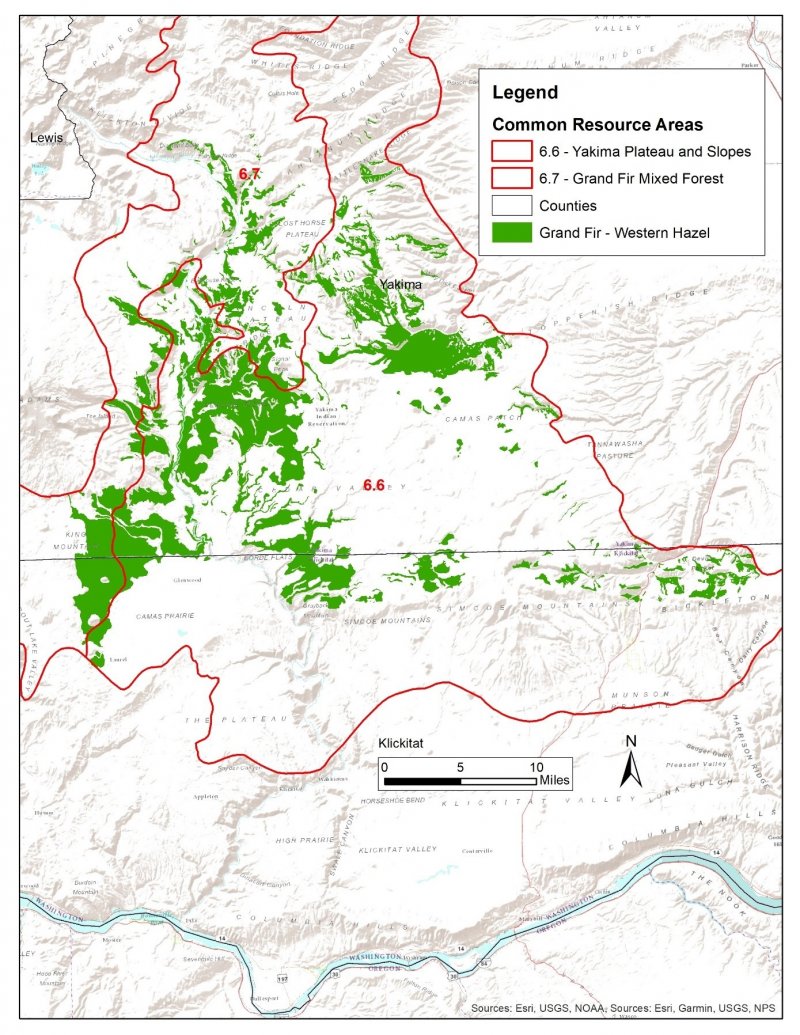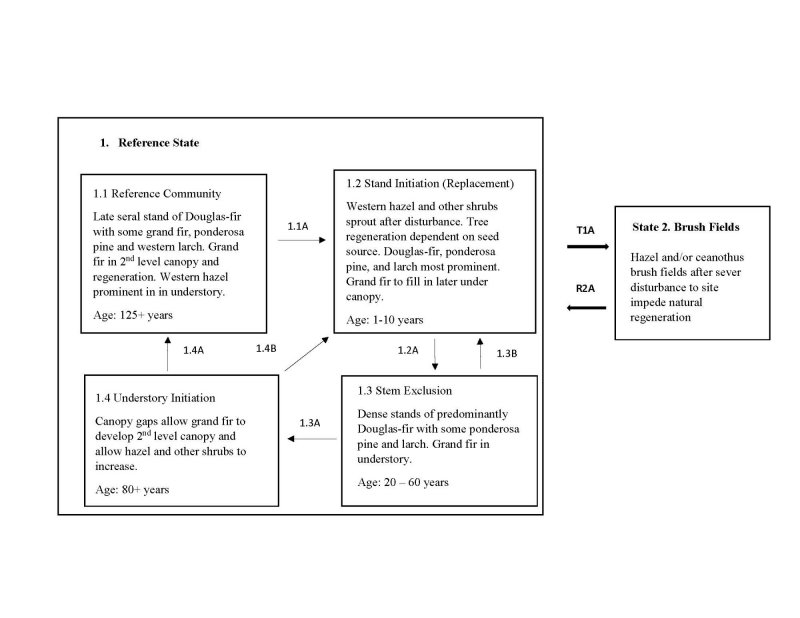
Natural Resources
Conservation Service
Ecological site F006XD005WA
Frigid Xeric Mountain Slopes and Plateaus (Grand fir Warm Moderately Dry Shrub)
Last updated: 4/01/2025
Accessed: 12/21/2025
General information
Provisional. A provisional ecological site description has undergone quality control and quality assurance review. It contains a working state and transition model and enough information to identify the ecological site.
MLRA notes
Major Land Resource Area (MLRA): 006X–Cascade Mountains, Eastern Slope
Major Land Resource Area (MLRA): 006X–Cascade Mountains, Eastern Slope.
Stretching from northern Washington to southern Oregon, MLRA 6 encompasses the mountain slopes, foothills, elevated plateaus and valleys on the eastern slopes of the Cascade mountains. This MLRA is a transitional area between the Cascade Mountains to the west and the lower lying Columbia Basalt Plateau to the east. Situated in the rain shadow of the Cascade Crest, this MLRA receives less precipitation than portions of the cascades further west and greater precipitation than the basalt plateaus to the east. Geologically, the majority of the MLRA is dominated by Miocene volcanic rocks, while the northern portion is dominated by Pre-Cretaceous metamorphic rocks and the southern portion is blanketed with a thick mantle of ash and pumice from Mount Mazama. The soils in the MLRA dominantly have a mesic, frigid, or cryic soil temperature regime, a xeric soil moisture regime, and mixed or glassy mineralogy. They generally are moderately deep to very deep, well drained, and loamy or ashy. Biologically, the MLRA is dominated by coniferous forest, large expanses of which are dominated by ponderosa pine, Douglas-fir or lodgepole pine. Areas experiencing cooler and moister conditions include grand fir, white fir, and western larch while the highest elevations include pacific silver fir, subalpine fir and whitebark pine. Economically, timber harvest and recreation are important land uses in these forests. Historically, many of these forests would have experienced relatively frequent, low and mixed severity fire favoring the development of mature forests dominated by ponderosa pine or Douglas-fir. In the southern pumice plateau forests, less frequent, higher severity fire was common and promoted the growth of large expanses of lodgepole pine forests.
LRU notes
Common Resource Area (CRA) 6.6 - Yakima Plateau and Slopes
This LRU occurs predominantly on mountain slopes, structural benches, canyons, and plateaus. The soils are dominantly in the Andisols taxonomic order, with some Alfisols, Inceptisols, and Mollisols. Soil parent materials are dominantly colluvium and residuum from basalt and andesite with a component of volcanic ash in the upper part. Taxonomic soil climate is a frigid temperature regime and xeric moisture regime with average annual precipitation of about 42 inches.
Other LRU'S where the site occurs:
CRA 6.7 - Grand Fir Mixed Forest
Classification relationships
Yakima Nation Plant Associations:
#7 – Grand fir/western hazel (ABGR/COCOC)
Ecological site concept
This ecological site is unique to the Yakima Indian Reservation in the southern area of CRA 6.8 mostly in Peavine Ridge and Toppenish Ridge areas. It occurs at elevations 2500 – 4500 feet on mostly north aspects. Stands are dominated by Douglas-fir with some ponderosa pine and western larch. Grand fir is in the sub-canopy and is the major regeneration species under the dense Douglas-fir canopy. This site can support good stocking of trees. Any canopy openings can become brushy. Main shrub species are western (California) hazel, spirea, snowberry, creeping snowberry, rose, and Douglas maple.
Associated sites
| F006XB003WA |
Frigid Xeric Mountain Slopes (Grand fir Warm Moderately Dry Low Shrub/Herb) |
|---|---|
| F006XC003WA |
Cool Frigid Moist Xeric Mountain Slopes (Grand fir Cool Moist Shrub/Herb) On slightly cooler sites. |
Similar sites
| F006XD002WA |
Cool Frigid Xeric Ashy Slopes (Grand fir Cool Dry Grass) On cooler sites. |
|---|
Table 1. Dominant plant species
| Tree |
(1) Abies grandis |
|---|---|
| Shrub |
Not specified |
| Herbaceous |
Not specified |
Click on box and path labels to scroll to the respective text.
Ecosystem states
| T1A | - | Severe fires |
|---|---|---|
| R2A | - | Control of shrub competition and replanting trees |
State 1 submodel, plant communities
| 1.1A | - | Stand replacing fire |
|---|---|---|
| 1.2A | - | Tree regeneration |
| 1.3B | - | Stand replacing fire |
| 1.3A | - | Time |
| 1.4A | - | Old growth dynamics |
| 1.4B | - | Stand replacing fire or mixed severity fires |

